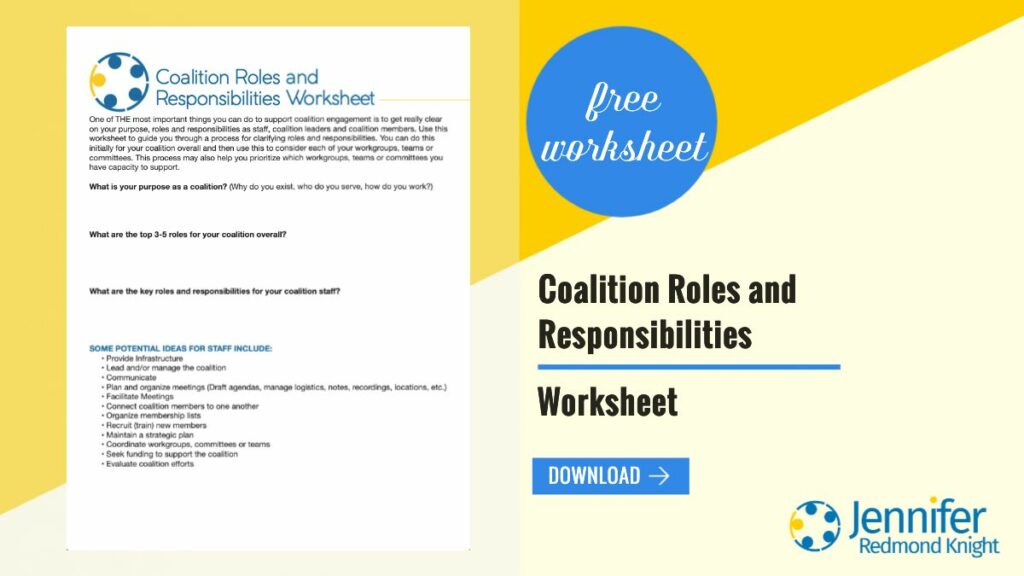Have you ever been in a coalition where you were not sure why you were there or what you were going to do? Have you been in a coalition that was clearly focused and seemed to be functioning smoothly? Coalitions, like other groups (think Tuckman’s stages of group development) have stages of development. And the people within coalitions often have varying stages of experience with the coalition. If a coalition has existed for many years, there are usually people who have been around since the beginning and others who are new to the group. If you are curious about your coalition’s stage of development, check out this post on four overarching stages of coalition development.
Formation.
Like any other group, the first stage of a coalition is formation. Within a coalition, you likely also have groups within the coalitions, such as workgroups, teams, committees or networks. The coalition overall may be in the formation stage or you may have specific workgroups that are beginning to develop. During this stage you are figuring out your purpose for gathering, how you operate, who will lead or staff the group, what kinds of things you want to do and who you want to join the group. During the coalition formation stage, you experience both the forming and storming elements described by Tuckman. At first, the group is often excited and energized by developing the purpose and overall expectations. As the group is continuing to figure out leadership, roles, expectations, there are often “storming” as the group works toward clarifying roles, leadership, organization and operation.
Activation.
When coalitions (or workgroups, teams, etc.) are in the activation phase, they are in the process of implementing strategies and working together to achieve common goals and objectives. The group knows what they are doing, where they are going and who is part of the group. While there will continue to be opportunities to recruit new members, during the activation stage, you have found a rhythm for meeting, have selected priorities and have clarified roles and responsibilities. You often have a clear workplan and budget aligned with the work of your coalition during the activation stage. This is where your group is most aligned with Tuckman’s “norming” stage. The coalition has a sense of belonging, trust and is focused on working together. During this stage, the coalition is communicating and connecting with one another and is beginning to see the benefit of what can happen when a group works together rather than as individual organizations.
Maintenance.
During the maintenance phase, the coalition decides to continue to work together toward common goals. This is most connected to Tuckman’s “performing” group development stage. The coalition has accomplished collective successes and plans to continue to work together. The members of the coalition respect one another, find value in one another’s work and often develop friendships that extend beyond the work of the coalition. During this stage, the coalition evaluates what has worked well and what can be improved in order to continue to work together toward common goals. The coalition members see their coalition involvement as a “win-win” for them personally, for their organization and for the coalition overall.
Refresh or Discontinue.
Once a coalition has been in the maintenance phase for a while, the group may become unsettled, expand their interests or have new leadership, staff and/or members who are interested in doing things differently. At this point the coalition (or respective workgroup or team) needs to decide whether to refresh and revisit the purpose, operations, etc. (even looking toward questions and discussions in the formation and activation stages) or whether it is time for the coalition to discontinue meeting as a formal group. If the coalition is ready to refresh, this is an excellent time to do strategic planning and listening sessions with those who are engaged with the coalition. If the coalition is ready to discontinue, consideration needs to be made for where the resources and materials developed by the coalition will go as well as how the discontinuation process will happen. For both of these areas, the group may need some external support in helping the group either refresh or discontinue working together in a way that brings positive closure.
So what about you? As you reflect on these coalition stages, which one is your coalition in right now? What about related workgroups, teams or committees?
As you are leading or participating in coalitions, one of the most important (and challenging) aspects is getting clear on roles and responsibilities. Check out my free Coalition Roles and Responsibilities worksheet that you can use to reflect and refine your coalition roles.
While the Coalition Action Theory described by Frances Butterfoss, provides some foundation in this idea, I realized in my experience that there are really more stages than originally described. If you want to see her theory, check out: Butterfoss, F. D., & Kegler, M. C. (2009). The community coalition action theory. In R. J. DiClemente, R. A. Crosby, & M. C. Kegler (Eds.), Emerging theories in health promotion practice and research (2nd ed., pp. 237–276). Jossey-Bass/Wiley.

Photo by Antonio Janeski on Unsplash

